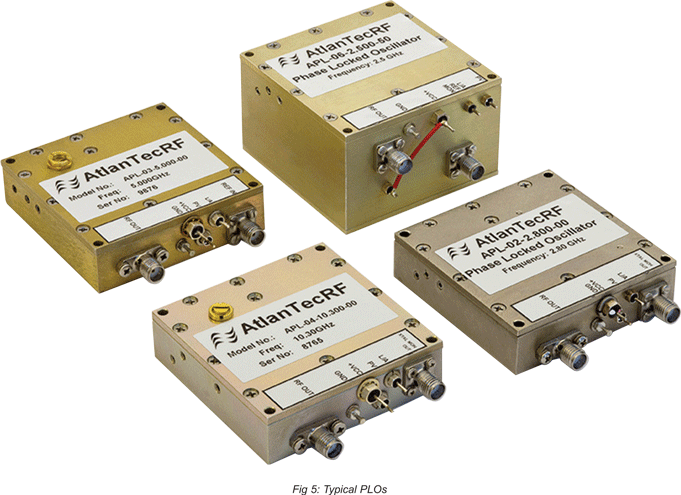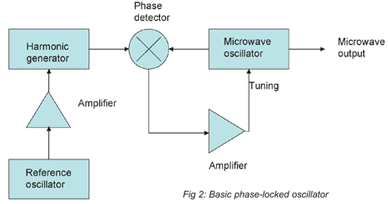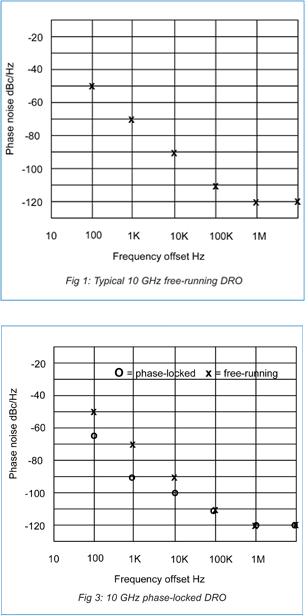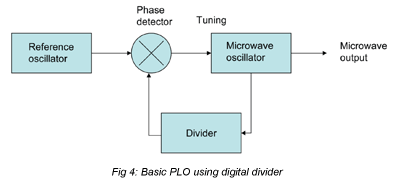
Microwave phase-locked oscillators are available in a number of architectures which all have different properties. The purpose of this article is to review some of the most popular types.
PLO fundamentals
All microwave oscillators exhibit noise spectra and the mechanisms producing these are well understood. In general, the dominant effect impacting on applications is FM noise (or phase noise, to which it is physically related) which may limit sensitivity, bit rate and channel spacing (amongst other things) in a typical communication system.
There are external sources of FM noise such as mechanical vibration and radiation from nearby digital circuits and power supply lines. Elimination of all of these spurious sources still leaves the fundamental noise mechanisms in the oscillator such as flicker noise and thermal effects which exhibit a generally continuous spectrum whose amplitude is affected by the Q of the oscillator circuit. Fig 1 illustrates the performance of a typical free-running oscillator in which it can be seen that close to carrier there is a significant amount of phase noise which declines to a low level floor further out.
The purpose of phase-locking the oscillator is to improve the close to carrier noise of an oscillator which has a good noise floor by superimposing a reference oscillator which has good close to carrier performance. In a typical PLO a crystal having excellent short-term stability is used as a reference for a DRO which has relatively poor short term stability but an excellent far from carrier noise floor.

 Oscillator. Typically, the reference is a crystal having a fundamental frequency in the range 20 to 200 MHz and a harmonic of it is compared with a sample of the microwave oscillator in a phase detector. The error output from the phase detector is applied to a tuning terminal on the oscillator. The bandwidth of the loop comprising the phase detector, amplifier and tuning mechanism of the oscillator determines the range of offset from the carrier over which the oscillator is phase-locked to the crystal. Within the loop bandwidth the dominant noise signal is that of the crystal degraded by the multiplication ratio (20logN, where N is the ratio of the output frequency to the reference frequency). Beyond the loop bandwidth the Q of the oscillator dominates the phase noise.
Oscillator. Typically, the reference is a crystal having a fundamental frequency in the range 20 to 200 MHz and a harmonic of it is compared with a sample of the microwave oscillator in a phase detector. The error output from the phase detector is applied to a tuning terminal on the oscillator. The bandwidth of the loop comprising the phase detector, amplifier and tuning mechanism of the oscillator determines the range of offset from the carrier over which the oscillator is phase-locked to the crystal. Within the loop bandwidth the dominant noise signal is that of the crystal degraded by the multiplication ratio (20logN, where N is the ratio of the output frequency to the reference frequency). Beyond the loop bandwidth the Q of the oscillator dominates the phase noise.
Fig 3 shows the effect of introducing a phase-locked loop to the oscillator depicted in Fig 1 where there has been a 20 dB improvement in close-in phase noise at 1KHz offset. The loop bandwidth is approximately 50 KHz and it can be seen that at 100 KHz the oscillator’s resonator is dominant.
Practical realisation
In microwave PLOs it is inevitable that the reference oscillator, usually a crystal, is operating at a large submultiple of the output frequency and traditionally the reference frequency has been multiplied. However, the ready availability of high speed digital dividers has made it possible to divide down the output frequency and allow the phase comparison to be performed at reference frequency. This offers some advantages in cost and simplicity but care has to be taken to ensure that phase noise is not compromised by the divider itself or by noise superimposed upon the oscillator power supply. A PLO based on a digital divider is illustrated in Fig 4.
It is evident that the reference frequency of the PLO must be a submultiple of the output frequency. Typically, internally-referenced microwave PLOs use crystal frequencies in the range 20 to 200 MHz which are specified to the correct submultiple of the output. It is not possible to completely suppress unwanted harmonics of the reference frequency which appear in the output. Fortunately with reference frequencies in this range the nearest reference-related spurious line is sufficiently far away from carrier to be well attenuated by the oscillator’s resonator and in any case so far from carrier that in many applications its presence is not significant. Typical reference-related spurious are -70 dBc.
When an external reference is used the choice of its frequency is very often not under the control of the PLO manufacturer. For instance, in a satellite earth station there may be a master station reference frequency of 5 or 10 MHz which is used for applications in addition to the PLOs. Two problems are posed. Firstly, a means has to be found to get from 5 MHz to the precise output frequency. Secondly, the 5 or 10 MHz reference frequency will produce unwanted sidebands which are sufficiently close to the carrier to become significant. Both of these issues are overcome by use of a dual phase-locked loop in which the reference frequency is divided down to a small number and used to phase lock a VHF PLO at a submultiple of the desired final output frequency. This is then multiplied and used to phase lock a second PLO at the desired frequency.

Another practical aspect is the need to bring the oscillator under control when power is first applied. Typically, a sawtooth waveform is applied to the tuning terminal to sweep over a sufficiently wide frequency range so that it can be gathered by the phase-locking circuit.
Apart from design issues such as ensuring that power supplies remain “clean”, a number of practical issues have to be faced by the PLO manufacturer and this is where experience plays an important part. For instance, a mechanical tuning adjustment may have to be carried out on the oscillator’s resonator to set the desired frequency. This affects the performance over temperature and in order to ensure a reliable start-up over the entire operating temperature range it is good practice to temperature test every product. Similarly, it is necessary to understand how loading the reference circuit affects the frequency and noise performance of the reference.
Various architectures are now described using Atlantic Microwave's models as examples:
- Simple internally-referenced PLO; APL-02 series. These use coaxial resonators at frequencies between 300 MHz and 3 GHz, and dielectric resonators at frequencies upto 14 GHz. Above 14 GHz, an output multiplier is used. A buffer amplifier is used in the output to minimise load pulling. A TTL lock alarm is provided together with a reference output. The power supply input is regulated and accepts +11 to +16 V dc. There is a standard operating temperature range of 0-50 deg C resulting in a stability of +/- 5 ppm with options of different temperature ranges and stabilities obtained by choice of crystal. The phase noise at 10 GHz is illustrated in Fig 3.
- Simple externally-referenced PLO; APL-03 series. This is essentially the same product as the internally-referenced PLO described above but the external reference has to be specified. For output frequencies between 300 MHz and 3 GHz the reference frequency has to be in the range 10 to 50 MHz; above 3 GHz it should be in the range 25 to 200 MHz. The close-in phase noise is determined by the reference source which is degraded by 20 logN + 3 dB; at 100 KHz and beyond it is the same as the APL-02.
- Internal TCXO-referenced PLO; APL-04 series. For more demanding stability requirements it is possible to fit an internal reference which employs a temperature-compensated crystal oscillator. The APL-04 offers +/- 1 ppm maximum over -20 to + 70 deg C with all other parameters similar to the APL-02. This is a good example of the benefit of a mature generic design which can be adapted to different requirements.
- Double loop externally referenced PLO; APL-05 series. Based on the successful APL-02 series, this product employs a reference loop to digitally derive a VHF reference from an external 5 or 10 MHz signal. This offers enhanced close-in performance similar to what would be achieved with a VHF reference; only at 100 Hz offset is the performance reference dependent.
- High stability internally-referenced PLO; APL-06 series. It is possible to incorporate an oven-controlled crystal reference oscillator (OCXO) in a PLO to provide the best possible temperature stability with an internal reference. This model has a stability of +/- 0.05 ppm max over -20 to +60 degC.
Summary
The PLO is a versatile low noise signal source which is available in different architectures to suit different applications and environments. All of these products (illustrated in Fig 5) have the same “industry standard” mechanical footprint of 2.25” (57.2 mm) square and they have internal power regulation and other user-friendly features. A wide range of options is also available.

